Related Research Articles
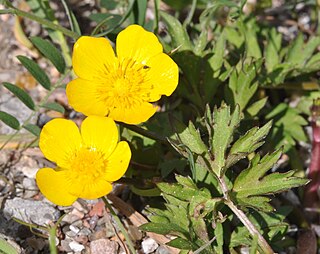
Flowering plants are plants that bear flowers and fruits, and form the clade Angiospermae, commonly called angiosperms. They include all forbs, grasses and grass-like plants, a vast majority of broad-leaved trees, shrubs and vines, and most aquatic plants. The term "angiosperm" is derived from the Greek words ἀγγεῖον / angeion and σπέρμα / sperma ('seed'), meaning that the seeds are enclosed within a fruit. They are by far the most diverse group of land plants with 64 orders, 416 families, approximately 13,000 known genera and 300,000 known species. Angiosperms were formerly called Magnoliophyta.

The European robin, known simply as the robin or robin redbreast in Great Britain and Ireland, is a small insectivorous passerine bird that belongs to the chat subfamily of the Old World flycatcher family. It is found across Europe, east to Western Siberia and south to North Africa; it is sedentary in most of its range except the far north.

Herbaceous plants are vascular plants that have no persistent woody stems above ground. This broad category of plants includes many perennials, and nearly all annuals and biennials.
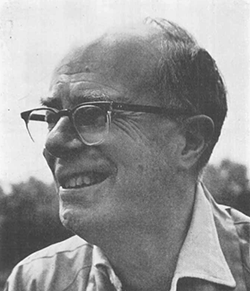
David Lambert Lack FRS was a British evolutionary biologist who made contributions to ornithology, ecology, and ethology. His 1947 book, Darwin's Finches, on the finches of the Galapagos Islands was a landmark work as were his other popular science books on Life of the Robin and Swifts in a Tower. He developed what is now known as Lack's Principle which explained the evolution of avian clutch sizes in terms of individual selection as opposed to the competing contemporary idea that they had evolved for the benefit of species. His pioneering life-history studies of the living bird helped in changing the nature of ornithology from what was then a collection-oriented field. He was a longtime director of the Edward Grey Institute of Field Ornithology at the University of Oxford.
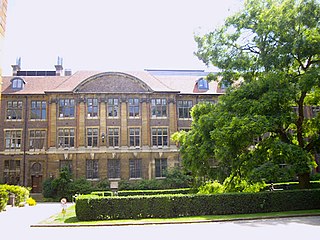
The Department of Plant Sciences is a department of the University of Cambridge that conducts research and teaching in plant sciences. It was established in 1904, although the university has had a professor of botany since 1724.
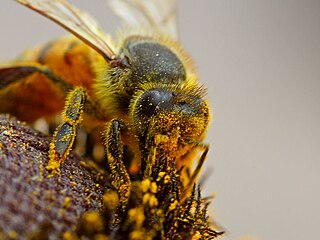
Entomophily or insect pollination is a form of pollination whereby pollen of plants, especially but not only of flowering plants, is distributed by insects. Flowers pollinated by insects typically advertise themselves with bright colours, sometimes with conspicuous patterns leading to rewards of pollen and nectar; they may also have an attractive scent which in some cases mimics insect pheromones. Insect pollinators such as bees have adaptations for their role, such as lapping or sucking mouthparts to take in nectar, and in some species also pollen baskets on their hind legs. This required the coevolution of insects and flowering plants in the development of pollination behaviour by the insects and pollination mechanisms by the flowers, benefiting both groups. Both the size and the density of a population are known to affect pollination and subsequent reproductive performance.

A pseudanthium is an inflorescence that resembles a flower. The word is sometimes used for other structures that are neither a true flower nor a true inflorescence. Examples of pseudanthia include flower heads, composite flowers, or capitula, which are special types of inflorescences in which anything from a small cluster to hundreds or sometimes thousands of flowers are grouped together to form a single flower-like structure. Pseudanthia take various forms. The real flowers are generally small and often greatly reduced, but the pseudanthium itself can sometimes be quite large.
Andrew James Henderson is a palm-systematist and Curator of the Institute of Systematic Botany at the New York Botanical Garden. He has authored taxonomic descriptions of 140 species, subspecies and varieties of plants, especially in the palm family

Giacomo Giuseppe Federico Delpino was an Italian botanist who made early observations on floral biology, particularly the pollination of flowers by insects. Delpino introduced a very broad view of plant ecology and was the first to suggest pollination syndromes, sets of traits associated with specific kinds of pollinators. He wrote Pensieri sulla Biologia Vegetale in 1867 and this failed to gather sufficient notice due to it being written in Italian. He corresponded with Charles Darwin and was one of the first to speculate on the idea of "plant intelligence".

The history of botany examines the human effort to understand life on Earth by tracing the historical development of the discipline of botany—that part of natural science dealing with organisms traditionally treated as plants.

David William Goodall was an English-born Australian botanist and ecologist. He was influential in the early development of statistical methods in plant communities. He worked as researcher and professor in England, Australia, Ghana and the United States. He was editor-in-chief of the 30-volume Ecosystems of the World series of books, and author of over 100 publications. He was known as Australia's oldest working scientist, still editing ecology papers at age 103. Long an advocate of voluntary euthanasia legalisation, he ended his own life in Switzerland via physician-assisted suicide at age 104.
Karl Joseph Niklas is the Liberty Hyde Bailey Professor emeritus in the Section of Plant Biology, School of Integrative Plant Science, at Cornell University. He is best known for his work on plant biomechanics, allometry, and functional morphology, and for his long-standing contributions to understanding plant evolutionary biology, particularly early land plant evolutionary diversification patterns and morphospaces.

Timothy Walker is a British botanist. He was the Horti Praefectus (Director) of the University of Oxford Botanic Garden and Harcourt Arboretum.
Michael Charles Faraday Proctor PhD was an English botanist and plant ecologist, lecturer, scientific author based at the University of Exeter. He retired from his post as Reader in Plant Ecology at Exeter University in 1994.
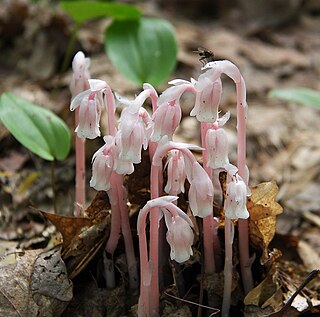
Monotropoideae, sometimes referred to as monotropes, are a flowering plant subfamily in the family Ericaceae. Members of this subfamily are notable for their mycoheterotrophic and non-photosynthesizing or achlorophyllous characteristics.
Jose Cuatrecasas Medal for Excellence in Tropical Botany was initiated in 2001 by the Smithsonian National Museum of Natural History, USA. It is named after José Cuatrecasas, a pioneering botanist and taxonomist who worked on the flora of tropical South America. It is awarded annually to a scientist who has made a very significant contribution to advancing the field of tropical botany. Nominations for the award can be made by all in the Botany Department at the museum.

Pollinator-mediated selection is an evolutionary process occurring in flowering plants, in which the foraging behavior of pollinators differentially selects for certain floral traits. Flowering plant are a diverse group of plants that produce seeds. Their seeds differ from those of gymnosperms in that they are enclosed within a fruit. These plants display a wide range of diversity when it comes to the phenotypic characteristics of their flowers, which attracts a variety of pollinators that participate in biotic interactions with the plant. Since many plants rely on pollen vectors, their interactions with them influence floral traits and also favor efficiency since many vectors are searching for floral rewards like pollen and nectar. Examples of pollinator-mediated selected traits could be those involving the size, shape, color and odor of flowers, corolla tube length and width, size of inflorescence, floral rewards and amount, nectar guides, and phenology. Since these types of traits are likely to be involved in attracting pollinators, they may very well be the result of selection by the pollinators themselves.
Andromonoecy is a breeding system of plant species in which male and hermaphrodite flowers are on the same plant. It is a monomorphic sexual system comparable with monoecy, gynomonoecy and trimonoecy. Andromonoecy is frequent among genera with zygomorphic flowers, however it is overall rare and occurs in less than 2% of plant species. Nonetheless the breeding system has gained interest among biologists in the study of sex expression.

Monoecy is a sexual system in seed plants where separate male and female cones or flowers are present on the same plant. It is a monomorphic sexual system comparable with gynomonoecy, andromonoecy and trimonoecy, and contrasted with dioecy where individual plants produce cones or flowers of only one sex.
Ann Kiku Sakai is a plant biologist at the University of California, Irvine known for her work on plant breeding and speciation. She is an elected fellow of the American Association for the Advancement of Science.
References
- ↑ Anderson, Ted R. (2013). The Life of David Lack: Father of Evolutionary Ecology. Oxford University Press. ISBN 978-0-19-992264-2.
- ↑ Dust jacket of Redbreast: The Robin in Life and Literature, SMH Books, 2008.
- 1 2 Christopher Howse, The Robin in life and literature. The Daily Telegraph , 27 December 2007.
- ↑ Clarissa Sebag-Montefiore SMH Books robin book success Archived 4 February 2013 at archive.today , theBookseller.com, 15 January 2009.
- ↑ "ISIS Chamber Orchestra". www.isischamberorchestra.org.uk. Retrieved 10 May 2021.
- ↑ Books by Andrew Lack, Amazon.co.uk.